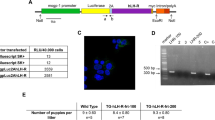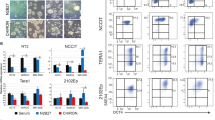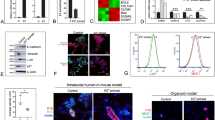Abstract
Mouse teratocarcinoma stem cells (embryonal carcinoma, or EC cells) bind very small amounts of mouse epidermal growth factor (EGF) and the latter hormone seems to have no stimulatory effect on the growth of two cloned lines of EC cells. However, when EC cells are induced to differentiate into large flat endodern-like cells (END cells), EGF receptors increase in number reaching a plateau in 6 to 8 days. At 8 to 10 days after induction, END cells multiply very slowly, but when EGF is added (3×10−10 M) to the medium, cell division is stimulated and a further change in morphology occurs. This letter describes the binding characteristics and numbers of the EGF receptors on EC and END cells and shows that exogenous retinoic acid increases the numbers of EGF receptors on END cells. We were unable to find endogenous competing factors produced by EC cells. Such factors could account for the lack of detectable binding of EGF on these cells. As EC cells differentiate to END cells, so the ability of the cells to form tumours is reduced1,2. Since this change is accompanied by an increase in the number of EGF receptors there may be a relationship between these two events.
This is a preview of subscription content, access via your institution
Access options
Subscribe to this journal
Receive 51 print issues and online access
$199.00 per year
only $3.90 per issue
Buy this article
- Purchase on Springer Link
- Instant access to full article PDF
Prices may be subject to local taxes which are calculated during checkout
Similar content being viewed by others
References
Adamson, E. D. & Graham, C. F. 3rd Int. Conference on Differentiation and Neoplasia (ed. McKinnell, R.) (Springer, Berlin, 1979).
Papaioannou, V. E., Evans, E. P., Gardner, R. L. & Graham, C. F. J. Embryol. exp. Morph. (in the press).
Bernstine, E. G., Hooper, M. L., Grandchamp, S. & Ephrussi, B. Proc. natn. Acad. Sci. U.S.A. 70, 3899–3903 (1973).
McBurney, M. W. J. cell. Physiol. 89, 441–455 (1976).
Stevens, L. C. Devl Biol. 20, 364–382 (1970).
Adamson, E. D. J. Embryol. exp. Morph. 35, 355–367 (1976).
Fletcher, L. et al. Devl Biol. 65, 211–224 (1978).
Hooper, M. L. & Slack, C. Devl Biol. 55, 271–284 (1977).
Burke, D. C., Graham, C. F. & Lehman, J. M. Cell 13, 243–248 (1978).
Adamson, E. D., Gaunt, S. J. & Graham, C. F. Cell 17, 469–476 (1979).
Strickland, S. & Mahdavi, V. Cell 15, 393–404 (1978).
Jetten, A. M. & Jetten, M. E. R. Nature 278, 180–182 (1979).
Solter, D., Shevinsky, L., Knowles, B. B. & Strickland, S. Devl Biol. 70, 515–521 (1979).
Carpenter, G. & Cohen, A. in Molecular Control of Proliferation and Differentiation (eds Papaconstaninou, J. & Rutter, W.J.) 13–31 (Academic, New York, 1978).
Gospodarowicz, D., Moran, J. S. & Mescher, A. L. in Molecular Control of Proliferation and Differentiation (eds Papaconstaniou, J. & Rutter, W. J.) 32–63 (Academic, New York, 1978).
Scatchard, G. Ann. N. Y. Acad. Sci. 51, 660–672 (1949).
Ware, L. M. & Axelrad, A. A. Virology 50, 339–368 (1972).
Adamson, E. D., Evans, M. J. & Magrane, G. G. Eur. J. Biochem. 79, 607–615 (1977).
Lehman, J. M., Speer, W. C., Swartzendruber, D. E. & Pierce, G. B. J. cell. Physiol. 84, 13–28 (1974).
Hogan, B. Nature 277, 261–262 (1979).
De Larco, J. E. & Todaro, G. J. Proc. natn. Acad. Sci. U.S.A. 75, 4001–4005 (1978).
Gavin, J. R. III., Buell, D. N. & Roth, J. Science 178, 168–169 (1972).
Todaro, G. J., De Larco, J. E. & Cohen, S. Nature 264, 26–31 (1976).
Lee, L-S. & Weinstein, I. B. Science 202, 313–315 (1978).
Shoyab, M., De Larco, J. E. & Todaro, G. J. Nature 279, 387–391 (1979).
Todaro, G. J., De Larco, J. E. & Sporn, M. B. Nature 276, 272–274 (1978).
Author information
Authors and Affiliations
Rights and permissions
About this article
Cite this article
Rees, A., Adamson, E. & Graham, C. Epidermal growth factor receptors increase during the differentiation of embryonal carcinoma cells. Nature 281, 309–311 (1979). https://doi.org/10.1038/281309a0
Received:
Accepted:
Issue Date:
DOI: https://doi.org/10.1038/281309a0
This article is cited by
-
Recombinant immunotoxins
Breast Cancer Research and Treatment (1996)
-
Secretion of polypeptides related to epidermal growth factor and insulinlike growth factor I by a human teratocarcinoma cell line
In Vitro Cellular & Developmental Biology - Animal (1991)
-
Alterations in EGF binding to acini during pancreatic regeneration in the rat
International journal of pancreatology (1988)
-
Influence of retinoids and EGF on growth of embryonic mouse palatal epithelia in culture
In Vitro Cellular & Developmental Biology (1988)
-
Expression of the human β-globin gene in mouse teratocarcinoma cells
Molecular and General Genetics MGG (1987)
Comments
By submitting a comment you agree to abide by our Terms and Community Guidelines. If you find something abusive or that does not comply with our terms or guidelines please flag it as inappropriate.



